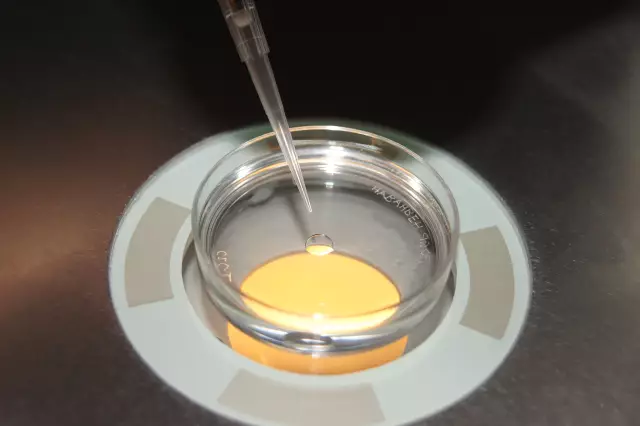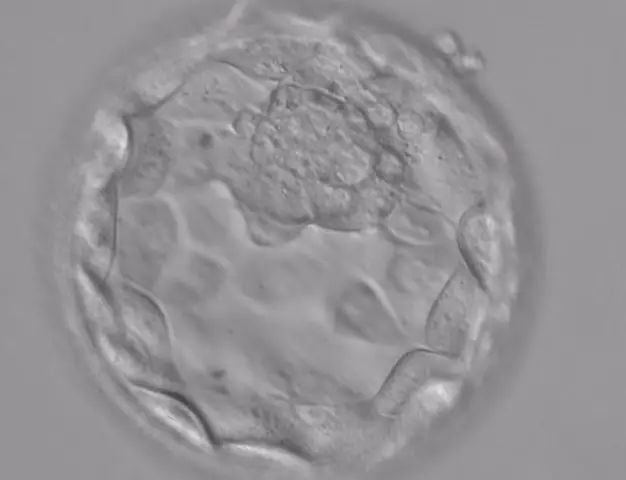- Author Curtis Blomfield [email protected].
- Public 2023-12-16 20:44.
- Last modified 2025-01-23 17:01.
Many couples dream of being happy parents, but such a diagnosis as infertility of one or both partners negates all hope. In this case, in vitro fertilization (IVF) comes to the rescue - a procedure that helps infertile couples give birth to a long-awaited child. It is necessary to carefully prepare for it, because the hormonal explosion in the body of a woman leads to increased production of eggs.
After that, the ovaries are punctured, that is, a special needle is used to take the liquid from them with the eggs contained in it. They are separated and placed in specially created conditions, where they are fertilized and begin to divide. The embryos are then transferred into the uterine cavity, and the woman waits for the onset of pregnancy.
But it happens that in the test tube in which the eggs were fertilized, more embryos were formed than thiswas necessary. In this case, doctors advise to carry out a procedure such as cryopreservation of embryos. They may be needed if the first IVF procedure was unsuccessful or the woman wants to have a second child in the future.
What is cryopreservation?
Cryoconservation of embryos is a procedure for safely freezing them in liquid nitrogen at a temperature of 196 degrees below zero. In this case, all biochemical processes stop, that is, the embryo stops developing, but if it is thawed, it remains viable.

Many women fail to get pregnant by IVF the first time. This happens only in 30-65% of cases. The second attempt forces the woman to undergo once again a very unpleasant and rather traumatic procedure for ovarian stimulation, as well as their puncture, accompanied by drug therapy.
Embryos frozen in liquid nitrogen can be considered a kind of safety net in case of failure. It has been proven that the transfer of cryopreserved embryos promotes pregnancy with almost the same chances as fresh ones.
Indications for cryopreservation
This complex procedure is performed when a woman:
- wants to become a surrogate mother;
- has genetic diseases and, prior to embryo transfer, underwent pre-implantation genetic diagnosis, as a result of which diseased embryos were weeded out, and the number of he althyexceeded 4-6 pieces;
- during the period of embryo transfer, she suddenly fell ill with viral or infectious diseases, which could provoke a spontaneous abortion or the birth of a child with various pathologies;
- wants to get pregnant again after some time;
- has already done IVF, but failed.
Embryo cryopreservation: pros and cons
This procedure has certain advantages. If a woman is infertile, then she can hope for a second pregnancy. Cryopreservation during repeated pregnancy significantly reduces the burden on the woman's body, because she no longer has to take large amounts of medication and undergo an ovarian puncture. This procedure allows you to save a lot during repeated IVF, because you no longer have to pay for hormone therapy and egg retrieval.

The chances of a second pregnancy are significantly increased, as the eggs are not only fertilized, but also began to divide, which does not always happen during IVF. The procedure using cryopreserved embryos prevents the development of ovarian hyperstimulation syndrome. This method also gives other couples a chance to become parents, as frozen embryos can be used as donors.
Thus, cryopreservation has a lot of advantages. But still, the procedure using cryopreserved embryos has one significant drawback. It lies in the fact that the percentage of loss of embryos during theirfreezing and defrosting is high enough.
How is cryopreservation performed?
From the fertilized eggs, the doctor selects the highest quality and he althiest embryos. They are then placed in a test tube and treated with a cryoprotectant to protect them from damage.

Each such tube is placed in microcontainers, which are plastic tubes that are labeled, and up to 5 embryos can be stored in them. After that, they are placed in a cryobank and cooled by ultra-fast or slow freezing. In a cryobank, storage of cryopreserved embryos lasts from a month to several decades, depending on the desire of a woman. The main condition for the cryopreservation process is good quality and high viability of embryos.
How does the process of thawing embryos take place?
Thaw embryos at room temperature. To do this, the tube in which they are located is taken out of the cryoprotector and transferred to a special environment. As soon as the embryo is completely thawed, it is transplanted into the uterine cavity.
Embryos after cryopreservation are transplanted in a natural or stimulated cycle, as well as in a cycle with hormone replacement therapy.
Required Medicines for Embryo Transfer
In order for the uterine mucosa to be ready for transfer, and the embryo to take root well, doctors prescribe various drugs containing the female hormone for this. Therefore, we will try to answer the question of what medicines to drink beforetransfer of cryopreserved embryos.

Progesterone preparations prepare the uterine mucosa well, as a result of which the embryo successfully takes root. Such medicines include "Duphaston" and "Utrozhestan". Proginova tablets also help prepare the uterus for embryo transfer.
How does thawed embryo transfer work?
Embryo transfer is carried out after menstruation occurs after an unsuccessful IVF attempt. The implantation of the blastocyst and crushing embryos into the uterus usually occurs on the day the embryos are thawed.
Embryo transfer and replanting after cryopreservation occurs in a natural, stimulated cycle or a cycle with hormone replacement therapy. This allows us to hope for the onset of a long-awaited pregnancy.

The result of the transfer depends on the following factors:
- woman's age;
- correct drug therapy;
- number of embryos transferred;
- number of complications in previous pregnancies.
During freezing, the shell of the embryo usually thickens, so before transferring it to the uterus, hatching is carried out, that is, its shell is notched.
Possible outcome of freezing and thawing embryos
It is possible that embryos, after being frozen and then thawed, will be completely unsuitable for transferdue to their destruction. In this case, the transfer will not be carried out.
Preparing the uterine mucosa for transplantation, a hormonal analysis is carried out, which will indicate its condition. If for some reason deviations of hormonal parameters from normal have occurred, the transfer procedure is canceled, because the uterine mucosa will be unprepared. In this case, they wait for the next cycle, in which the endometrium is re-prepared.
Is it possible to cryopreserve embryos more than once?
This is possible if a large number of embryos are frozen at an early stage of development, after which almost all of them are thawed. Having chosen the best specimens for replanting, the rest are frozen again. The transfer of these double cryopreserved embryos promotes pregnancy, but still some factors reduce the successful outcome.
Can cryopreservation affect the development of children?

Parents are very concerned about how a child will develop from a cryopreserved embryo. Special studies were carried out to establish mental, physical, intellectual deviations in the development of such children. The results failed to reveal any abnormalities. The percentage of children with pathologies born from cryopreserved embryos did not exceed the percentage of children with pathologies born as a result of natural conception.
Cost of procedure
Many women, as well as married couples, are interested in the question: how much does cryopreservation of embryos cost? The cost of everythinga cycle in which frozen material is used will be several times lower than the amount that a repeated full IVF protocol will cost. The cost of the service depends on how long the cells will be stored in cryostorage, whether donor material was used, on the method of freezing, the number of stored embryos.

In our country, the cost of cryopreservation is from 6 to 30 thousand rubles. You will have to pay 1,000 rubles for storing embryos for a month, and 10,000 rubles for a year. If the biomaterial is placed in a separate cryostorage, then the cost of storage for one month is 4 thousand rubles.
Conclusion
Thus, we can conclude that cryopreservation helps many women get pregnant after an unsuccessful IVF attempt and does not affect the he alth of the newborn in any way. Many couples believe that this procedure is very useful as an assistive technology in the IVF protocol, helping them to make extra insurance.






